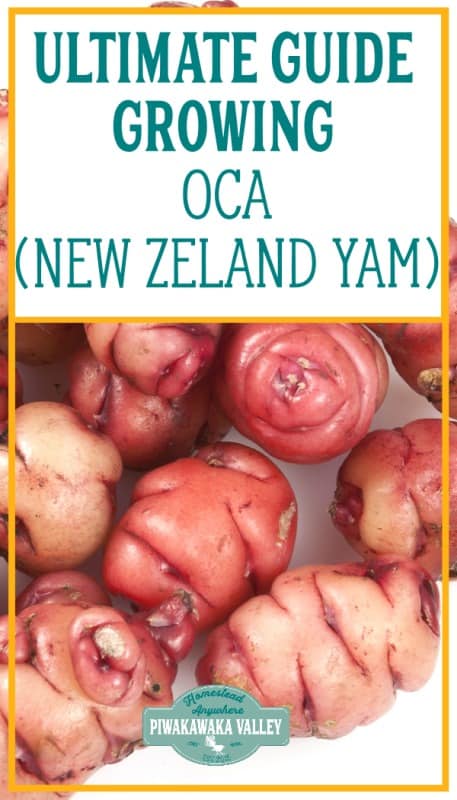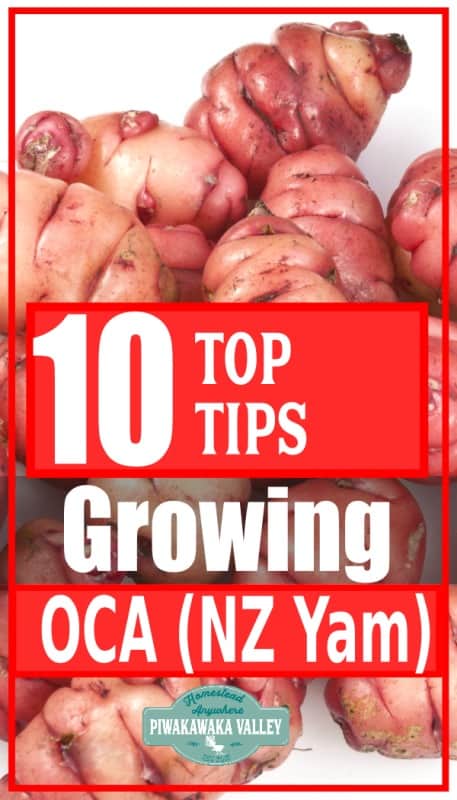Growing Oca (Oxalis tuberosa or New Zealand Yam) is an increasingly common activity for home gardeners. Oca is a small tuber that is as popular as the potato in the Andes but it does not suffer blight, so knowing how to grow oca is a great way of building a resilient, sustainable and food-secure garden in your backyard.
What is Oca or New Zealand Yam?
Oca is a tuber crop native to the Andes, where it was developed alongside other tuber crops potato, ulluco, and mashua.
Please read: This information is provided for educational purposes only and is not intended to treat, diagnose or prevent any disease. We encourage you to make your own health care decisions in partnership with a qualified health care professional.
This post contains affiliate links, this means at no extra cost to you, we make a commission from sales. Please read our Disclosure Statement
Oca tubers are usually long and narrow and rounded, reaching up to about four inches in length. Colours range from cream, to yellow, pale orange and red/pink.
This crop is easy to grow in cooler areas including all of New Zealand and the UK. In America it will grow in most of the Pacific Northwest, but it tends to struggle in the rest of the country.
Per plant yields can reach up to 1.5kg/ three pounds in favorable climates, but are usually lower.
Cooked tubers are somewhat softer than potatoes and have a variety of flavors, from mild to acidic and a bit sweet to starchy. They are delicious roasted with meat, or sprinkled in brown sugar and balsamic vinegar.
Tubers are produced during the short days of autumn/ fall and they rely on the lower sun hours to develop.
Oca is a perennial due to regrowth from tubers, but it has an annual lifecycle. Oca is a perfect addition to a food forest setting as the like the cool damp environment offered by being an understory plant.
RELATED: 10 Reasons you should grow a food forest
How to Grow Oca
Growing New Zealand yam is very easy and hands off once you get a good bed established.
Oca performs best in cool, maritime climates, where it should be planted in full sun. It thrives where summer temperatures do not rise above 85° F (30 C) for long periods of time and can tolerate very high altitudes.
Oca is usually propagated by planting tubers. True seeds are produced only under favorable conditions and are used for breeding. You can also grow them from stem cuttings or slips if tubers are hard to come by.
When to sow oca
Tubers or seedlings are typically planted out in the spring, any time after risk of frost has passed. In warm summer climates, oca will do most of its growing in spring and fall, sulking through the summer, so it benefits from earlier planting if it gets hot where you are.
Row spacing of 45 cm / 18 inches works very well to allow the plants to grow nice large tubers.
You can plant them as close as 12 inches (30 cm) apart. This will produce the same number of tubers, but they are smaller. Wider spacing also increases air circulation around the plants, which may help to prevent disease in warm, humid climates.
Growing Oca from tubers
Tubers are typically planted whole. You can cut tubers for more plants, in the same way you would with seed potatoes. Make sure each piece has at least two eyes and let them heal for a few days in a humid environment before planting to reduce the risk of rot.
You can also pull sprouts (or slips) from tubers and plant the individual sprouts, this is useful if tubers are hard to come by.
Slips root easily and quickly but you will have less of a harvest than if you had grown from a large tuber.
Plant whole tubers and seed pieces about two to three inches (5 to 7.5 cm) deep (shallower for smaller pieces and deeper for larger). Orientation of the tuber doesn’t appear to matter. I usually plant them horizontally, which is how most are found at harvest.
Growing Oca from Seed
Oca does not grow true to type by seed. So if you want a specific variety, you need to use the tubers.
Start your seeds in winter or spring, about 10 weeks before your last frost. This will give you seedlings to transplant outdoors after the frosts.
Oca germinates over a long period, and has unreliable germination. It is best left to people wanting to discover new varieties.
Care of Oca plants
Many growers recommend hilling oca as it grows, in the same way you do with potatoes.
With experimenting I have found that when I hill oca, I harvest more tubers, but they are smaller on average and I prefer bigger yams, so I do not hill my oca.
Growing oca under mulch has been recommended as a good strategy for protecting oca in warmer climates. This makes good sense, since mulching cools the soil and retains water, both of which are important for healthy oca plants.
While mulching may delay sprouting in the spring, oca does most of its growing in the autumn, so late emergence is probably not a problem in most areas.
I prefer to grow mine under mulch anyway to keep the weeds at bay!
Plants need plenty of water, so if you are not getting regular rain it is recommended that you water them often enough to keep the top inch of soil moist.
Growing Oca in containers
Oca does well in very large containers, but smaller pots will reduce yield. Containers often dry out and are difficult to keep moist and cool enough for oca to thrive.
If you are able to keep them cool and well watered, then you might have some luck growing your oca in a pot.
Harvesting Oca
Please remember is that the tubers form and swell as autumn develops, when day length shortens and temperatures fall so your oca does not form underground tubers until very late in the season.
Do not worry if the foliage gets frosted as it will die off after a heavy frost. Do not harvest the underground tubers until the last remnants of foliage has become frosted and died off.
The longer you can leave the tubers in the soil the better and bigger they will be.
Fork gently around the edge of the plant and lift the tubers carefully, taking care not to bruise or damage them.
Sit them somewhere warm and dry for 1-2 days to dry them and then store in slatted trays or a hessian sack in a cool shed or garage.
Unlike potatoes, oca tubers do not need covering against the light, and will store happily for several months until they start to sprout and some of these can be replanted. For longer storage keep cold and humid, the vegetable chiller in your fridge is perfect.
Eating Oca
Oca has a distinct lemony sweet flavour, this is due to the oxalates and starches that the tubers contain.
All parts of the oca plant can be eaten raw or cooked however, the tubers are most the frequently eaten part. The flesh is firm but juicy and crisp when eaten raw or lightly cooked, and becoming more starchy if fully cooked.
If you want to eat the oca tubers raw, you might like to sit them in the sun for several days to a few weeks as this sweetens them.
Oca can be cooked in any way that a potato can be cooked and can be readily used as a substitution in recipes that call for potatoes, carrots, and many other root vegetables.
Most people will either boil or roast oca until fork tender.
We usually either roast them in with meat for 40-60 minutes, or drizzle with a little oil and roast at 180C/350F.
There is no need to peel oca, although peeling does reduce the tartness as this is more prevalent in the thin waxy skin.
Oca stems can be used like rhubarb, they are much more tart than the tubers and they do die off with frosts, so if you want to eat them you will have to harvest the stems before the frosts arrive.
Leaves can be eaten raw and provide a sour flavor similar to other sorrels.
In the Andes, a marmalade is sometimes made from oca tubers with sugar. Oca is also sometimes used to make a weak alcoholic drink, chicha de oca.
They also make an excellent addition to winter soups and stews. Our Oca loses its skin colour on boiling and turns a more cream colour and loses any lemon flavour, becoming more nutty in taste.
Oca tubers contain over 70% water but are nutritionally rich with carbohydrate, calcium and iron.
Oca are a member of the oxalis family (which is evident when the plants are growing, with their distinctive oxalis leaf shape) but oca are not invasive. However, I prefer not to rotate oca through my garden as any tiny missed tuber or root fragment can re-grow in to a plant and you will have oca EVERYWHERE!
Oca makes a great addition to any garden, even if you just grow it for its pretty foliage.
If you would like help getting the most out of your garden, I would love to help you, find out more here
RELATED: Free Gardening Resources
If you like tips on frugal living, self sufficiency and consuming less, sign up to our newsletter below, I would LOVE to have you
For further reading, I really recommend all of these books. I own every one of them and they are amazing resources!































